1 - 100 of 62
| Creator | Title | Description | Subject | Date | ||
|---|---|---|---|---|---|---|
| 1 |
 |
Sarofim, Adel F.; Pugmire, Ronald J. | 13C NMR analysis of soot produced from model compounds and a coal | Soot samples, including the associated organics, produced from an Illinois No. 6 coal (five samples) and two model compounds, biphenyl (three samples) and pyrene (two samples), have been studied by 13C NMR methods. The coal soot data served as a guide to selection of the temperature range that would... | 13C NMR; Biphenyl; Aromatic cluster size | 2001 |
| 2 |
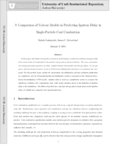 |
Sutherland, James Clayton | A comparison of various models in predicting ignition delay in single-particle coal combustion | In this paper, individual coal particle combustion under laminar conditions is simulated using models with various levels of complexity for the particle and gas phase chemical kinetics. The mass, momentum and energy governing equations are fully coupled between the particle and the gas phase. In the... | 2014-01-01 | |
| 3 |
 |
Sutherland, James Clayton | A filter-independent model identification technique for turbulent combustion modeling | In this paper, we address a method to reduce the number of species equations that must be solved via application of Principal Component Analysis (PCA). This technique provides a robust methodology to reduce the number of species equations by identifying correlations in state-space and defining new v... | 2012-01-01 | |
| 4 |
 |
Whitty, Kevin J. | A pulse-width modulation controlled wire-mesh heater apparatus for investigation of solid fuel pyrolysis | A novel wire mesh heater apparatus has been developed to study the devolatilization of solid fuels under pressurized conditions at well-controlled heating rates on the order of 1000 K/s. The apparatus combines direct current and pulse-width modulation with a fast-acting and high current-capacity re... | 2012-01-01 | |
| 5 |
 |
Whitty, Kevin J. | A system for measuring bubble voidage and frequency around tubes immersed in a fluidized bed of particles | Gas-solid fluidized beds are common in chemical processing and energy production industries. These types of reactors frequently have banks of tubes immersed within the bed to provide heating or cooling, and it is important that the fluid dynamics within these bundles is efficient and uniform. This p... | 2010 | |
| 6 |
 |
Sutherland, James Clayton; Kerstein, Alan R. | A unified approach to the various formulations of the one-dimensional-turbulence model | The One-Dimensional Turbulence (ODT) model has been successfully applied as a stand-alone model for predicting turbulence statistics in both nonreacting and reacting flows. There are several formulations of the model in the literature, and most of the variable-density formulations do not clearly dis... | 2010 | |
| 7 |
 |
Sutherland, James Clayton | Advanced regression methods for combustion modelling using principal components | Modelling the physics of combustion remains a challenge due to a large range of temporal and physical scales which are important in these systems. Detailed chemical kinetic mechanisms are used to describe the chemistry involved in the combustion process yielding highly coupled partial differential e... | 2014-01-01 | |
| 8 |
 |
Sutherland, James Clayton; Kerstein, Alan R.; Chen, Jaqueline H. | An evaluation of the one-dimensional turbulence model: comparison with direct numerical simulation of CO/H2 jets with extinction and reignition | Abstract A variant of the One-Dimensional Turbulence (ODT) model formulated in an Eulerian reference frame is applied to a planar nonpre mixed turbulent jet flame and results from the model prediction are compared with DNS data. The model employed herein solves the full set of conservation equation... | 2010 | |
| 9 |
 |
Pershing, David W. | Bench and pilot scale process evaluation of reburning for in-furnace NOx reduction | This paper describes a combined experimental and theoretical study which was undertaken to quantify the impact of fuel and process parameters on reburning effectiveness and provide the scaling information required for commercial application of reburning under highly varied industrial conditions. Ini... | Reburning; Nitrogen oxides reduction; Staged fuel injection | 1986 |
| 10 |
 |
Pershing, David W. | Biomass combustion: relationship between pollutant formation and fuel composition | A 65-kW refractory-walled reactor was used to study biomass combustion under conditions typical of the suspension-burning phase in a spreader-stoker-fired boiler. Isothermal combustion data and nitric oxide (NO) emission rates were obtained as a function of temperature, local oxygen concentration, ... | Combustion; Emissions; Energy; Environmental control; Fuels; Pyrolysis; Biomass fuel; Particulates | 1989 |
| 11 |
 |
Lighty, Joann; Sarofim, Adel F. | Carbon dioxide effects on metal vaporization during coal combustion | Coal combustion products may take one of two forms. Residual ash (> 1 micron) is formed by particle shrinkage and breaking during combustion. Some material will vaporize and later recondense. During recondensation, these molecules have a high affinity for submicron particles because of the large sur... | Coal combustion products; Metal vaporization; Carbon dioxide; Residual ash | 2001 |
| 12 |
 |
Pershing, David W. | Control of NOx and particulate emissions from spreader-stokers fired with hogged wood | The formation and emission of nitrogen oxides and particulate carry-over were studied from spreader-stoker combustion of hogged Douglas-fir, with a focus on optimizing the combustion conditions in each of the two distinct combustion zones, the bed phase and the suspension phase local oxygen availabi... | Chemical analysis; Combustion; Emission; Engineering; Environmental control; Fuels; Nitrogen compounds; Particulates; NOx; Hogged wood | 1987 |
| 13 |
 |
Pershing, David W. | Control of NOx emissions | NITROGEN OXIDES (NOX) are produced in combustion from molecular nitrogen (thermal NOx) or from oxidation of nitrogen contained in the fuel (fuel NOx). Production of NOx in a turbulent diffusion flame is largely dependent upon fuel composition and fuel/air contacting, which for liquid fuels is determ... | Staged heat release; Tunnel furnace; Boiler simulator; Staged combustion | 1980 |
| 14 |
 |
Pershing, David W. | Design and construction of a rotary kiln simulator for use in studying the incineration of hazardous waste | Rotary kilns have been used extensively in the cement industry to calcine limestone. In the past few years, the technology has been viewed as a possible option for the incineration of hazardous waste materials, especially for the disposal of solid wastes and the cleanup of contaminated soils and tra... | Rotary kilns; Hazardous waste; Waste burning | 1989-08 |
| 15 |
 |
Ring, Terry Arthur; Eddings, Eric G.; Sarofim, Adel F. | Determination of soot refractive index as a function of height in an inverse diffusion flame | With the scope of combustion diagnostics increasing, it is becoming ever more important for some of the more basic physical properties of soot to be addressed. Soot refractive index values were obtained as a function of height in a benzene inverse diffusion flame (IDF). The IDF was chosen for ease i... | Inverse diffusion flame | 2007 |
| 16 |
 |
Rashid, Khalid; Powell, Kody | Dynamic simulation, control, and design of a novel solar thermal hybrid power plant | Solar power is among the promising technologies leading towards cleaner fuel. However, there are still technological challenges regarding the reliability of power generation due to its intermittency. This work demonstrates the synergies that exist in integrated hybrid systems, where a dispatchable f... | Solar energy--Research; Solar thermal energy--Research; Solar power plants--Research | 2017 |
| 17 |
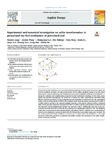 |
Eddings, Eric G. | Experimental and numerical investigation on sulfur transformation in T pressurized oxy-fuel combustion of pulverized coal | Pressurized oxy-fuel combustion, as a novel and promising technology for CO2 capture from power plants, has attracted worldwide attentions. The high partial pressure of CO2 induces significant changes to the SOx release characteristic. Properly addressing these fundamental issues and technological c... | Pressurized; Oxy-fuel combustion; SO2 emission; Numerical; Pulverized coal | 2019 |
| 18 |
 |
Eddings, Eric G.; Sarofim, Adel F. | Experimental study of burning rate in jet-fuel pool fires | Experiments were carried out in a 30 cm diameter pool fire, for both transient and steady-state conditions, utilizing jet fuel, Norpar-15, and a surrogate mixture of hydrocarbons that simulates jet-fuel behavior in a pool fire. Steady state pool fire tests match previous results well. The transient ... | Pool fires; Jet propulsion fuel; Norpar-15 | 2004 |
| 19 |
 |
Eddings, Eric G.; Sarofim, Adel F. | Fast cook-off tests report | The Center for the Simulation of Accidental Fires and Explosions (C-SAFE) at the University of Utah is focused on providing science-based tools for the numerical simulation of accident scenarios involving fires and high-energy devices (Pershing, 2000). The initial computational efforts are concentra... | Heat flux; Heat transfer; Cookoff tests; Center for the Simulation of Accidental Fires and Explosions; C-SAFE | 2003 |
| 20 |
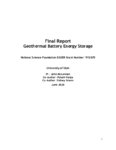 |
McLennan, John | Final Report Geothermal Battery Energy Storage | Solar and wind power are being introduced into electric grids to supplement and replace conventional electricity production. The deployment of utility-scale storage has not kept pace to overcome the intermittent nature of solar and to a lesser extent wind. Large-scale energy storage is cur... | 2020-06 | |
| 21 |
 |
Pershing, David W. | Formation and control of NO emissions from coal-fired spreader-stoker boilers | Stoker coal-fired furnaces are significant in terms of coal consumption and environmental impact; however, they have received little research attention. This paper describes the results of a study on the formation and control of nitrogen oxides in coal-fired spreader-stoker systems. Three scales of... | Stoker coal-fired furnaces | 1983 |
| 22 |
 |
Lighty, Joann; Silcox, Geoffrey | Fundamentals of mercury oxidation in flue gas | This report was prepared as an account of work sponsored by an agency of the United States Government. Neither the United States Government nor any agency thereof, nor any of their employees, makes any warranty, express or implied, or assumes any legal liability or responsibility for the accuracy, ... | 2006 | |
| 23 |
 |
McLennan, John | Geothermal Battery Surface Facilities Economics and Finance as an O&G play | |||
| 24 |
 |
Ring, Terry Arthur | Growth kinetics of hexagonal sub-micrometric β-tricalcium phosphate particles in ethylene glycol | Recently, uniform, non-agglomerated, hexagonal b-tricalcium phosphate (b-TCP) platelets (diameter 400-1700 nm, h 100-200 nm) were obtained at fairly moderate temperatures (90-170 C) by precipitation in ethylene glycol. Unfortunately, the platelet aspect ratios (diameter/thickness) obtained in the ... | 2014-01-01 | |
| 25 |
 |
Stringfellow, Gerald B.; Shurtleff, James Kevin | Heterostructures in GaInP grown using a change in Te doping | In organometallic vapor phase epitaxy, changes in growth conditions can be used to modulate the extent of CuPt ordering and, hence, the band gap energy of GaInP. One method is to add Te during growth. An increase in the band gap energy of 0.1 eV due to a decrease in ordering has been obtained by ... | Heterostructures; Alloys | 2000 |
| 26 |
 |
Pershing, David W. | Influence of coal composition on the fate of volatile and char nitrogen during combustion | Fifty coals from North America, Europe, Asia, South Africa and Australia were burned in a 21 kW, refractory-lined tunnel furnace to determine the influence of coal properties on the fate of volatile and char nitrogen. Excess air fuel NO emissions (as determined by combustion in Ar/02/C02) ranged fro... | Coal composition; Char nitrogen; Volatile nitrogen; NO emissions | 1982 |
| 27 |
 |
Pershing, David W. | Influence of fuel composition and flame temperature on the formation of thermal and fuel NOx in residual oil flames | A 900 kw model package boiler and a 20 kw laboratory tunnel furnace were used to study fuel and thermal NO, formation during heavy oil combustion. Package boiler results indicated that atomizer design, spray/ flow field interactions, and fuel composition were significant, dependent parameters. These... | Residual oil flames | 1979 |
| 28 |
 |
Pershing, David W.; Wendt, Jost O. L. | Investigation of first- and second-stage variables on control of NOx emissions using staged combustion in a pulverized coal wall-fired furnace | Recent tests on an EPA 1- to 1.5 x 106 Btu/hr pilot-scale pulverized coal furnace show that N0X emissions of 100 ppm to 150 ppm (zero percent 02) are achievable with the use of two-stage combustion. Comparable N0X emission levels were obtained with three different coal types fired in either the sing... | NOx; Carbon monoxide; Emissions | 1979 |
| 29 |
 |
Eddings, Eric G. | Joint NSF-NSFC Workshop on Combustion Related to Sustainable Energy | A workshop on Combustion Related to Sustainable Energy was held in Hangzhou, China on March 10-12, 2014. The workshop was jointly sponsored by the U.S. National Science Foundation (NSF) and by the National Science Foundation of China (NSFC). The purpose of the workshop was to bring together a limite... | Combustion, sustainable energy, research needs, climate change, renewable fuel, efficiency, Workshop China | 2016 |
| 30 |
 |
Eddings, Eric G.; Sarofim, Adel F. | Journey from n-heptane to liquid transportation fuels. 1. The role of the allylic radicals and its related species in aromatic precursor chemistry | The Utah normal heptane mechanism compiled from submechanisms in the literature was extended into a detailed normal decane combustion mechanism, which is a subset of the Utah surrogate mechanisms. Few species have greater impact on the concentrations of other species than the allyl radical CH2CHCH2.... | Utah Surrogate Mechanisms; Heptane mechanism; Decane combustion mechanism; Allyl radical; Aromatic precursors | 2008 |
| 31 |
 |
Sarofim, Adel F.; Truong, Thanh | Kinetics of hydrogen abstraction reactions from polycyclic aromatic hydrocarbons by H atoms | An application of the Reaction Class Transition State Theory/Linear Energy Relationship (RC-TST/LER) is presented for the evaluation of the thermal rate constants of hydrogen abstraction reactions by H atoms from Polycyclic Aromatic Hydrocarbons (PAH). Two classes of reactions have been considered, ... | Reaction Class Transition State Theory; Linear Energy Relationship; Hydrogen abstraction reactions | 2004 |
| 32 |
 |
McLennan, John | Large-scale subsurface seasonal heat storage for future value | I too extend my welcome. And, I extend thanks to the NSF for the support of this research at the Univ. of Utah. The concept of storing heat in the ground is certainly not new. Many, many cases have investigated heat to be stored underground. Getting the heat underground is somewhat of a problem, but... | 2020-05-19 | |
| 33 |
 |
Eddings, Eric G.; Sarofim, Adel F. | Mechanism reduction and generation using analysis of major fuel consumption pathways for n-heptane in premixed and diffusion flames | Reaction pathway analyses were conducted for three mechanisms (designated as the Pitsch, Utah, and Lawrence Livermore National Lab) for a normal heptane premixed flame (? = 1.9) and a normal heptane opposed diffusion flame, in order to identify the relative importance of the major fuel consumption p... | Pitsch mechanism; Utah mechanism; Lawrence Livermore National Lab mechanism; Mechanism reduction; Heptane premixed flame | 2007 |
| 34 |
 |
Pershing, David W. | Mechanisms of NOx formation and control: alternative and petroleum-derived liquid fuels | Petroleum-, coal- and shale-derived liquid fuels were burned in a downfired tunnel furnace to assess the impact of fuel properties on the formation and control of NOx emissions. A nitrogen-free oxidant mixture (Ar, C02 , 02) was used to isolate fuel NOx formation. Under excess air conditions fuel N... | Exhaust emissions; Alternative fuels; Petroleum-derived liquid fuels | 1981 |
| 35 |
 |
Eddings, Eric G.; Sarofim, Adel F. | Modeling benzene and naphthalene formation in a premixed propylene flame | The Utah Surrogate Mechanism was used to model a fuel-rich, non-sooting premixed laminar flame of propylene at 5000 Pa with an equivalence ratio of 2.32. The simulation results were found to be satisfactory in comparison with the experimental data. For example, the measured concentration profiles of... | Utah Surrogate Mechanism; Propylene; Combustion modeling; Benzene formation; Naphthalene formation | 2005 |
| 36 |
 |
Lighty, Joann; Sarofim, Adel F.; Eddings, Eric G. | Modeling the coagulation of charged particles | One important mechanism in the growth of soot particles is to understand the role of particle charge in the coagulation of the particles. A previously developed model has been extended to include the coagulation of charged particles. The model includes neutral particles and charged particles (up to ... | Charged particles; Flame ionization; Modeling | 2004 |
| 37 |
 |
Eddings, Eric | Modified CPD Model for Coal Devolatilization at UCTT Conditions | To study coal pyrolysis behavior at underground coal thermal treatment (UCTT) conditions, a modified CPD (M-CPD) model was developed and evaluated using two scales of experiments as well as two different coals, Utah Sufco and Illinois #6. Compared with the original CPD model, three major aspects wer... | Coal; pyrolysis; modeling; underground heating | 2019 |
| 38 |
 |
Sarofim, Adel F.; Eddings, Eric G. | Muiltifunctional fuel additives for reduced jet particlate emissions | Using Government drawings, specifications, or other data included in this document for any purpose other than Government procurement does not in any way obligate the U.S. Government. The fact that the Government formulated or supplied the drawings, specifications, or other data does not license the ... | 2006 | |
| 39 |
 |
Eddings, Eric G. | NOx emissions from intermediate-temperature combustion of steel-industry by-product gases | A study of NOx emissions from the combustion of coke-oven gas and blast-furnace gas (steel industry by-product gases) was undertaken using detailed kinetic modeling to elucidate the pathways for NOx formation. The study was performed at the intermediate temperatures (1200-1400K) and 1 atm, which rep... | 2004 | |
| 40 |
 |
Sarofim, Adel F. | Numerical combustion of aviation fuel part I: a cross-model comparison of n-heptane premixed flame | Four different n-heptane mechanisms were used to simulate a fuel rich n-heptane premixed flame and their results were compared with experimental measurements. In addition to discussion of the numerical performance of each mechanism, flux analysis coupled with the atomic distribution technique was us... | Aviation fuel; n-heptane; Premixed flame | 2003 |
| 41 |
 |
Eddings, Eric G.; Sarofim, Adel F. | Olefin chemistry in a premixed n-heptane flame | Three different n-heptane mechanisms were used to simulate a fuel-rich normal heptane premixed flame in order to identify major reaction pathways for olefin formation and consumption and areas of uncertainties of these reactions. Olefins are formed mainly via ?-scission and hydrogen abstraction, and... | Heptane mechanism; N-heptane; Olefin formation; Olefin consumption; Alkyl radicals | 2007 |
| 42 |
 |
Pershing, David W.; Slaughter, David Michael | Parameters influencing the evolution and oxidation of sulfur in suspension phase coal combustion | Stoker coal-fired boiler furnaces are significant in terms of coal consumption and environmental impact; however, they have received relatively little research attention. This paper describes the results of a two-year study on the formation of sulfur oxides in the suspension phase of a coal-fired s... | Stoker coal-fired furnaces | 1983 |
| 43 |
 |
Eddings, Eric G.; Sarofim, Adel F. | Pollutant emissions from gasoline combustion. 1. Dependence on fuel structural functionalities | To study the formation of air pollutants and soot precursors (e.g., acetylene, 1,3-butadiene, benzene, and higher aromatics) from aliphatic and aromatic fractions of gasoline fuels, the Utah Surrogate Mechanisms is extended to include submechanisms of gasoline surrogate compounds using a set of mech... | Pollutant emissions; Soot precursors; Gasoline surrogate compounds; Utah Surrogate Mechanisms | 2008 |
| 44 |
 |
Eddings, Eric G. | The potential of on-line optical flow measurement in the control and monitoring of pilot-scale oxy-coal flames | Digital image processing techniques oer a wide array of tools capable of extracting apparent displacement or velocity information from sequences of images of moving objects. Optical flow algorithms have been widely used in areas such as traffic monitoring and surveillance. The knowledge of instantan... | 2014-01-01 | |
| 45 |
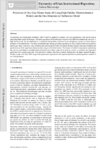 |
Sutherland, James Clayton | Prediction of oxy-coal flame stand-off using high-fidelity thermochemical models and the one-dimensional turbulence model | An Eulerian one-dimensional turbulence (ODT) model is applied to simulate oxy-coal combustion, with specific aim at predicting flame stand-o distances. Detailed gas-phase chemical kinetics based on the GRI3.0 mechanism are utilized. A high-fidelity model for devolatilization is considered that predi... | 2014-01-01 | |
| 46 |
 |
Eddings, Eric G.; Sarofim, Adel F.; Pershing, David W. | Production of nitrogen oxide during char oxidation at pulverized coal combustion conditions | More stringent regulations for NOx control in pulverized coal combustors have made the scientific community focus on sources of emissions that were traditionally considered less relevant to the overall NOx production. The oxidation to NO of the nitrogen that is organically bound to the char is one o... | 2001 | |
| 47 |
 |
Pershing, David W.; Wendt, Jost O. L. | Pulverized coal combustion: NOx formation mechanisms under fuel rich and staged combustion conditions | A 2 Kg/h pulverized fuel one dimensional flame combustor was used to determine time resolved NO profiles under fuel rich and staged combustion conditions. Seven solid fuels, including two coal chars, were investigated. Results show that at all fuel rich conditions NO is formed rapidly and then is ... | Flame; Composition; Reaction | 1979 |
| 48 |
 |
Pershing, David W.; Wendt, Jost O. L. | Pulverized coal combustion: the influence of flame temperature and coal composition on thermal and fuel NOx | A laboratory combustor was used to investigate the factors that influence the conversion of fuel nitrogen in coal during coal combustion. Fuel NO was isolated by experimentation utilizing Argon / Oxygen / Carbon Dioxide mixtures as the oxidant, and care was taken to compare cases with air at matche... | Fuel nitrogen; Flame temperature; Coal composition | 1977 |
| 49 |
 |
Smith, Philip J. | Reduced-order PCA models for chemical reacting flows | One of the most challenging aspects of turbulent combustion research is the development of reduced-order combustion models which can accurately reproduce the physics of the real system. The identification and utilization of the low dimensional manifolds in these system is paramount to understand and... | 2014-01-01 | |
| 50 |
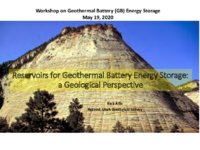 |
Allis, Rick | Reservoirs for Geothermal Battery Energy Report: a geological perspective | Workshop presentation | 2020-05-18 | |
| 51 |
 |
Lighty, Joann | The role of open innovation in development of futuristic technologies for carbon capture in coal-fired power plants: an academic perspective | Coal is an important fossil fuel resource for electricity generation which also contributes to significant CO2 emissions. The process of capturing carbon dioxide for utilization and sequestration is an important area of research in this domain. Academia-industry collaborations are playing a signific... | 2012-01-01 | |
| 52 |
 |
Ring, Terry Arthur | Room temperature co-precipitation synthesis of magnetite nanoparticles in a large pH window with different bases | Magnetite nanoparticles (Fe3O4) represent the most promising materials in medical applications. To favor high-drug or enzyme loading on the nanoparticles, they are incorporated into mesoporous materials to form a hybrid support with the consequent reduction of magnetization saturation. The direct sy... | 2013-01-01 | |
| 53 |
 |
Eddings, Eric G.; Sarofim, Adel F.; Pugmire, Ronald J. | Selection of surrogates for jet fuels | Abstract: A. detailed characterisation of JP fuels is provided based on literature data for the average of 55 worldwide and 4 US Jet-A fuels. These are complemented by NMR analysis of a JP-8 that provides the fractions of the carbon in the fuel that are present as protonated, bridgehead, and non-sub... | Jet propulsion fuel; Surrogates; Simulations | 2008 |
| 54 |
 |
Sarofim, Adel F. | Simulation of soot formation using particle dynamics with one dimensional nucleation mode | Two soot formation models using particle dynamics with one-dimensional nucleation mode directly coupled with gas phase chemistry are tested on three ethylene and three methane laminar premixed flames. These models demonstrate strength in the prediction of concentration profiles of major combustion p... | Soot formation models; Particle dynamics; One dimensional nucleation mode; Combustion chemistry | 2004 |
| 55 |
 |
Smith, Philip J. | Soot in combustion simulations | Soot is the dominant source of radiative heat transfer from most practical flames. A review is presented of historical, empirical modelling approaches for estimating heat flux from fires and flames. These historical methods have drawn on empiricism to address the role of soot while seeking methods f... | Large eddy simulation; LES; Combustion simulation; Radiative heat transfer; Pool fires | 2005 |
| 56 |
 |
Eddings, Eric G.; Spinti, Jennifer C.; Smith, Philip J. | Soot volume fraction from extinction in JP-8 and heptane pool fires | Total extinction measurements from a multiple beam experiment using a 10mW laser diode are presented and compared to calculate soot volume fraction in heavily sooting pool fires from a 150 mm diameter pan of Jet Propulsion fuel 8 (JP-8) and heptane. Trends in attenuation are critiqued for the t... | Pool fires; Jet propulsion fuel | 2005 |
| 57 |
 |
Eddings, Eric G.; Smith, Philip J. | Soot volume fraction from extinction in JP-8 and heptane pool fires | Total extinction measurements from a multiple beam experiment using a 10mW laser diode are presented and compared to calculate soot volume fraction in heavily sooting pool fires from a 150 mm diameter pan of Jet Propulsion fuel 8 (JP-8) and heptane. Trends in attenuation are critiqued for the t... | Soot volume fraction; Heptane pool fires; JP-8 pool fires; Heavily sooting pool fires; Laser diagnostics | 2005 |
| 58 |
 |
Veranth, John M.; Pershing, David W.; Sarofim, Adel F. | Sources of unburned carbon in the fly ash produced from low-NOx pulverized coal combustion | The unburned carbon in the fly ash produced from low-NOx pulverized coal combustion is shown to consist of a mixture of soot and coal char. The soot was identified by the presence of chains or aggregates of 10-50-nm-diameter primary particles in electron microscope images of both laboratory sample... | Unburned carbon; Char | 1998 |
| 59 |
 |
Smith, Philip J. | State space sensitivity to a prescribed probability density function shape in coal combustion systems: joint β-PDF versus clipped Gaussian PDF | The turbulent transport of three coal off-gas mixture fractions is coupled to a prescribed joint //-probability- density-function (//-PDF) mixing model. This physical transport and subgrid joint //-PDF mixing model is used to explore the incorporation of coal off-gas compositional disparities betwe... | Off-gas stream; β-PDF; Char oxidation | 2000 |
| 60 |
 |
Eddings, Eric G.; Sarofim, Adel F. | Thermal behavior of a high-energy material immersed in a fire | One of the uncertainties in the calculations of time-to-explosion for containers of high-energy materials immersed in fires is that of the thermal boundary at the container-explosive interface. Understanding this interface is critical in evaluating risks, safety issues and prevention mechanisms. In ... | 2004 | |
| 61 |
 |
Ring, Terry Arthur | Validation of energy moments from the one-dimensional energy dependent neutron diffusion equation, MCNP5 and Attila-7.1.0 with the GODIVA experiment | Normalized neutron energy moments (moments) from the one-dimensional energy dependent neutron diffusion equation (EDNDE), Monte Carlo N Particle 5 version 1.40 (MCNP5) and Attila-7.1.0-beta version (Attila) are validated with the GODIVA experiment (GODIVA). Energy moments 0-5 for all three methods a... | 2012-01-01 | |
| 62 |
 |
Ring, Terry Arthur | Verification of analytic energy moments for the one-dimensional energy dependent neutron diffusion equation with MCNP5 and Attila-7.1.0 | The energy dependent neutron diffusion equation (EDNDE) is converted into a moment equation which is solved analytically for the 1-D problem of a bare sphere of pure 235U. The normalized moments 0-5 generated analytically are compared to normalized energy moments, from Monte Carlo N Particle 5 versi... | 2012-01-01 |
1 - 100 of 62
